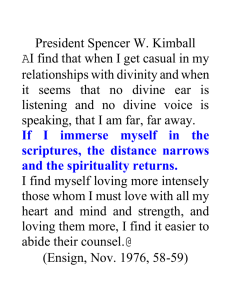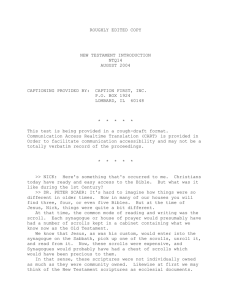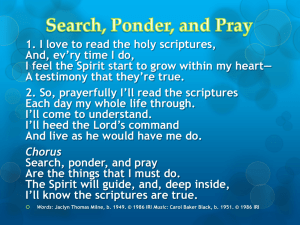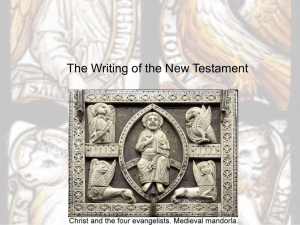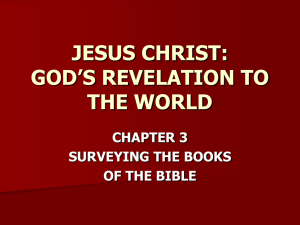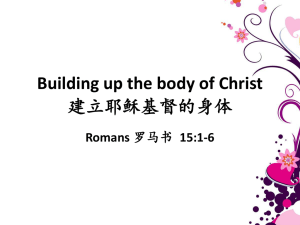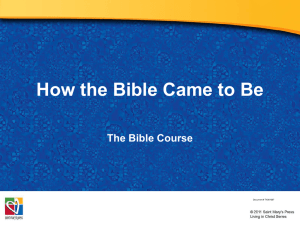Becoming Familiar with the New Testament
advertisement
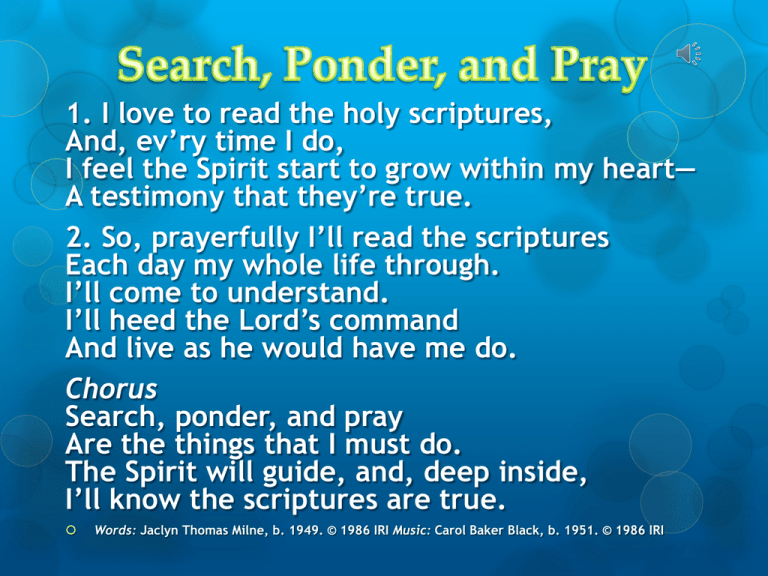
1. I love to read the holy scriptures, And, ev’ry time I do, I feel the Spirit start to grow within my heart— A testimony that they’re true. 2. So, prayerfully I’ll read the scriptures Each day my whole life through. I’ll come to understand. I’ll heed the Lord’s command And live as he would have me do. Chorus Search, ponder, and pray Are the things that I must do. The Spirit will guide, and, deep inside, I’ll know the scriptures are true. Words: Jaclyn Thomas Milne, b. 1949. © 1986 IRI Music: Carol Baker Black, b. 1951. © 1986 IRI Becoming Familiar with the New Testament “Lesson 1: Becoming Familiar with the New Testament,” Primary 7: New Testament, 1 Can you guess what I’m thinking of? • There are four of these. • Someone in the class has these. • They are called the standard works. • They contain the word of God. • They are books. This lesson will teach us about the scriptures and explain their importance in our lives. What are the scriptures? How is scripture different from other writings? Let’s read 2 Timothy 3:16 Why do we need to study the scriptures? When should we start studying the scriptures? Let’s read 2 Timothy 3:14–15 Why is it important to start studying the scriptures when we are young? We call the scriptures the standard works because they are the official scriptures we use in the Church. What do you know about the scriptures? In which of the standard works do we read about Jesus Christ? Let’s read the following verses: Moses 8:24 (through the words Holy Ghost) Doctrine and Covenants 20:29 2 Nephi 25:26 Psalm 83:18 (Jehovah is another name for Jesus Christ) Let’s read Luke 24:27 Jesus studied and taught from the scriptures often. What part of the scriptures would Jesus have studied? The Old Testament. Enrichment Activity 5 All four standard works testify of Jesus Christ. Open your Bibles to the contents page (list of the books in the Old and New Testaments). What two major sections is the Bible divided into? What is the list under each section? The smaller books in the Old and New Testaments were written by different prophets or Church leaders. Where do we find the account of Jesus’ mortal life and ministry? The lessons this year will focus on teachings from the New Testament. Let’s memorize the books of the New Testament in order! Matthew, Mark, Luke, John, the Acts and Romans, First and Second Corinthians, Galatians, Ephesians, Philippians, Colossians, First and Second Thessalonians, Timothy, Timothy, Titus, Philemon Then to the Hebrews, Epistle of James, Peter, Peter, John, John, John, Jude, Revelation— These are the books of the New Testament. Words: Anon. © 1978 IRI Music: Scottish folk song; adapted W. W. Phelps, 1792–1872 (tune of “Praise to the Man”) Enrichment Activity 1 Who were Matthew, Mark, Luke, and John? What did they write about? Each of these four men wrote an account of Jesus’ life, often writing about the same events, and testified that he was the Savior. What is your favorite story or teaching from Jesus’ life? Turn to Acts, chapter 1. Acts tells about the Apostles teaching the gospel after Jesus’ death and resurrection. What kind of things do you think the Apostles of Jesus’ time did? What do the Apostles do today? Turn again to the contents page. Most of the rest of the books in the New Testament are letters written by Jesus’ Apostles or other Church leaders to members of the Church. Why do you think these letters were written? These letters helped the early members of the Church understand the gospel and counseled them to be faithful. What do we have in the Church today that are like these letters? Articles by General Authorities in Church magazines, satellite broadcasts, and general and stake conferences. Each book in the New Testament is divided into chapters and verses so we can easily find a phrase in the scriptures. Matthew 28:2–9 In which of the standard works will we find this scripture? Which number tells us the chapter? Which numbers tell us the verses? What is this scripture account about? Why is it important to have this event recorded in the scriptures? We believe the Bible to be the word of God as far as it is translated correctly; we also believe the Book of Mormon to be the word of God. Enrichment Activity 2 Our Bible was translated from old documents that had been copied and recopied by hand. Mistakes were made in both the translation and recopying. Even though most of the Bible is accurate, the prophet Nephi wrote that many “plain and precious things” (1 Nephi 13:28) have been taken out. Enrichment Activity 2 The Prophet Joseph Smith reviewed the Bible through the inspiration of God and added parts that had been removed or changed. These parts help us understand more things about the gospel. Enrichment Activity 2 I’m going to take the wordstrips off the board and put them on the table. I’m going to ask some questions. If you know the answer, raise your hand. If you are correct, you can come up and display the wordstrip that has the answer on it. Enrichment Activity 6 Which two wordstrips mean the same thing? Which two wordstrips name books that are part of a third book? Which books are included in the standard works? Enrichment Activity 6 I bear my testimony of the truth of the scriptures and know their importance in our lives. There have been many times in my life when reading the scriptures helped me. I encourage you to read from the scriptures daily. Images and clipart are from lds.org, sugardoodle.net, Microsoft Office, and other websites indicating the images were in the public domain. The hymn and lesson are from lds.org Please do not use this presentation for commercial use. Feel free to alter the presentation for use in church or home to suit personal preference. This presentation is intended to supplement, not replace, the lesson manual and scriptures. Teachers should refer to the manual, scriptures and other resources when preparing and conducting the lesson.
